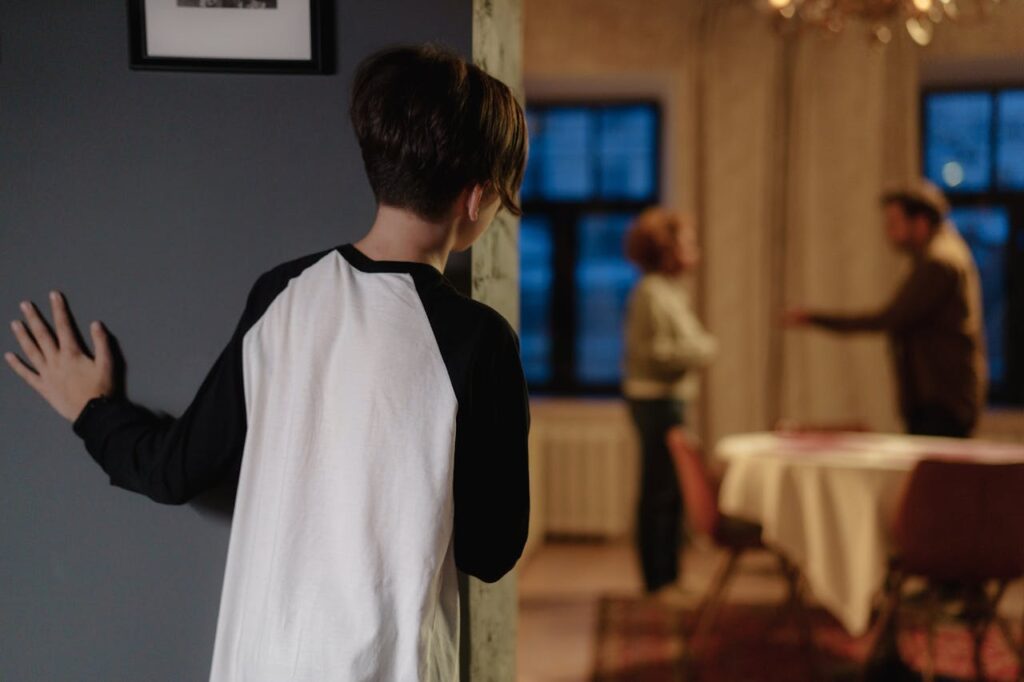Growing up in a broken home leaves deep marks that are often invisible to others. When a child experiences conflict, neglect, abandonment, or instability, they learn to adapt in ways that protect them from more pain. Many of these adaptations carry into adulthood, shaping how people handle relationships, emotions, and stress. Instead of openly expressing their true feelings, they often develop masks that keep others at a safe distance. These masks can look like confidence, humor, or selflessness, but underneath lies unspoken hurt and vulnerability. Understanding these patterns is not about judgment, but about recognizing the hidden weight some people carry and how it affects the way they interact with the world.
1. Using Humor to Deflect Pain
Humor can be a powerful survival tool. People who grew up in broken homes often develop a quick wit or playful attitude as a way to distract from pain. Joking about their struggles gives them control over the narrative and prevents others from seeing their vulnerability. On the surface, this humor may make them seem lighthearted or unbothered, but in reality, it often hides deep sadness or frustration. By making others laugh, they shift attention away from their own needs, protecting themselves from rejection. The problem is that humor can create distance, making it harder for others to recognize when they are truly hurting.
2. Becoming Overly Independent
For many who lacked dependable support growing up, independence became a necessity. They learned early not to rely on anyone else, so as adults, they insist on handling everything alone. This fierce independence looks admirable, but it often masks a deep fear of being let down again. They may avoid asking for help, even when overwhelmed, because needing others feels dangerous. This self-reliance creates an invisible wall, making it difficult for others to see their struggles. The independence that once kept them safe can turn into isolation, leaving them with no outlet for their true feelings.
3. Acting Like Everything Is Fine
Keeping up appearances is another common mask. Many from broken homes learn to put on a cheerful front, no matter what is happening inside. Smiling, making small talk, and acting as though nothing is wrong keeps people from asking questions. This performance often began in childhood, when showing distress could have made things worse or gone unnoticed. As adults, they continue to pretend everything is fine, even when overwhelmed. The danger is that their struggles remain hidden, and others assume they do not need support. Over time, pretending can become exhausting, leaving them disconnected from their own feelings.
4. Avoiding Conflict at All Costs
If a home was filled with yelling, arguments, or unpredictable tension, conflict often feels threatening in adulthood. Many choose to avoid disagreements completely, even if it means staying silent about their needs. They might agree with others to keep the peace, even when they feel strongly about an issue. This avoidance masks feelings of anger, sadness, or frustration, keeping them bottled inside. On the surface, they appear calm and easygoing, but inside they may feel resentful or unheard. By hiding from conflict, they protect themselves from fear, but they also lose opportunities for honest connection.

5. Becoming People Pleasers
When love and acceptance felt uncertain in childhood, some people learned to earn approval by pleasing others. As adults, they may go out of their way to meet everyone’s needs, even at the expense of their own. They say yes when they want to say no, put others first, and avoid expressing disappointment. This behavior makes them appear kind and generous, but underneath lies fear of abandonment or rejection. People pleasing becomes a mask that hides insecurity, giving the illusion of confidence and selflessness. Over time, this habit can lead to burnout and resentment, since their true feelings remain buried.
6. Hiding Behind Perfectionism
In many broken homes, children feel pressure to be perfect as a way to avoid criticism or keep the household stable. That drive for perfection often carries into adulthood. They push themselves to excel at work, in relationships, or in personal goals, believing mistakes will make them unworthy of love. To others, they look ambitious and capable, but their perfectionism hides deep self-doubt. The pursuit of flawless performance keeps them from showing vulnerability, because vulnerability feels like failure. While perfectionism can lead to success, it also creates constant stress, making it hard to relax or accept their own humanity.
7. Using Anger as a Shield
Not everyone hides behind kindness or humor. For some, anger becomes the mask of choice. When softer emotions like sadness or fear feel unsafe, anger steps in to cover them. They may lash out, stay defensive, or keep others at a distance with harsh words. This behavior makes them appear strong or untouchable, but inside they are often carrying unspoken pain. Anger gives the illusion of control, protecting them from feeling vulnerable again. Unfortunately, it can also push away the very people who might offer support, leaving them trapped in a cycle of loneliness and frustration.
8. Staying Busy All the Time
Another way people mask their emotions is by filling every moment with activity. Work, hobbies, exercise, and social events become distractions from deeper feelings. Staying busy makes it easier to avoid loneliness, sadness, or memories of instability. On the outside, they appear productive and successful, but underneath they may be avoiding silence because silence feels unsafe. Constant busyness leaves little room for reflection, making it harder to recognize their true emotions. Eventually, this pattern can lead to exhaustion, since avoiding feelings takes just as much energy as facing them.
9. Distracting With Caregiving
Some people cope by focusing all their energy on taking care of others. They may become the friend who always listens, the partner who sacrifices, or the worker who carries extra responsibility. This caregiving role often begins in childhood, when they had to take on responsibilities too early, such as looking after siblings or even their parents. In adulthood, it continues as a way to mask their own needs. Helping others makes them feel useful and loved, but it also keeps their own emotions hidden. Over time, this constant self-sacrifice can leave them drained and unseen.
10. Numbing With Substances or Food
When emotions feel overwhelming, some people turn to substances or habits that dull the pain. Alcohol, drugs, overeating, or even compulsive spending can become coping mechanisms. These behaviors provide temporary relief, but they also hide sadness, fear, or emptiness. To others, the behavior may look like indulgence or carelessness, but underneath it is an attempt to block out feelings that feel too heavy. While these habits mask emotions effectively in the moment, they create new challenges and can prevent true healing from taking place.

11. Keeping Relationships Superficial
Deep emotional intimacy can feel dangerous for those from broken homes. To protect themselves, they may keep friendships or romantic relationships on a surface level. They talk about safe topics, avoid sharing personal struggles, and maintain emotional distance. This makes them appear independent or private, but in reality, it masks fear of rejection. By not letting others get too close, they avoid the risk of being hurt again. The downside is that they also miss out on the depth of connection that comes with vulnerability.
12. Using Sarcasm as a Defense
Sarcasm is another tool that hides vulnerability. It creates distance, making it harder for others to see genuine emotions. For someone from a broken home, sarcasm can serve as armor, signaling that they are not to be taken lightly. While it may appear witty or clever, it often covers insecurity and sadness. Sarcasm allows them to deflect emotional conversations, protecting themselves from opening up. The result is that others may see them as detached or even cynical, when in reality, they are simply afraid of showing their softer side.
13. Minimizing Their Own Pain
A common pattern is downplaying their struggles. People may say, “it wasn’t that bad” or “others had it worse” as a way to dismiss their own hurt. This minimization makes them appear resilient, but it hides real suffering. By convincing themselves their pain does not matter, they avoid the discomfort of addressing it. The habit of minimizing often starts in childhood, when they felt ignored or when comparing themselves to others who seemed worse off. As adults, it prevents them from fully processing emotions and keeps their true feelings hidden.
14. Overachieving to Prove Worth
For some, success becomes a mask. They work tirelessly to prove they are capable and worthy of respect. Achievements in school, career, or personal life create an image of confidence and strength. However, beneath the accomplishments often lies deep self-doubt. They may believe their value comes only from performance, not from who they are as a person. This overachieving masks feelings of inadequacy, but it also leads to burnout. No matter how much they accomplish, it rarely feels like enough because the underlying wound has not been addressed.
15. Smiling Through the Hurt
Perhaps the most common mask is a simple smile. Many people from broken homes learn to cover their sadness with cheerfulness. A smile convinces others they are fine, even when they feel broken inside. This habit begins in childhood, when showing pain might have been ignored or punished. In adulthood, the smile becomes automatic, keeping others from asking questions. While it hides pain effectively, it also prevents authentic connections, since others never see the real feelings behind the mask.
Final Thoughts
Growing up in a broken home shapes how people learn to survive emotionally. The masks they wear protect them from rejection, abandonment, or conflict, but they also prevent genuine healing and connection. While these coping strategies once served a purpose, they can create barriers in adulthood. Recognizing these patterns is the first step toward change. By becoming aware of their masks, people can begin to unlearn old habits and express their emotions more honestly. True healing happens when they allow themselves to be seen, not for the mask they wear, but for the person they truly are.
Disclaimer: This article was created with AI assistance and edited by a human for accuracy and clarity.

